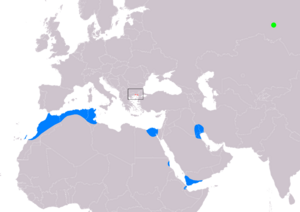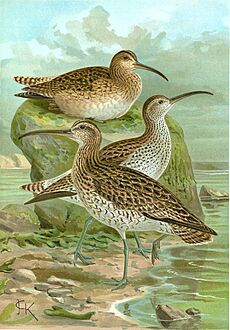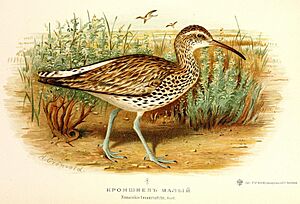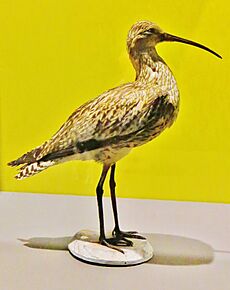Slender-billed curlew facts for kids
Quick facts for kids Slender-billed curlew |
|
|---|---|
| Conservation status | |
| Scientific classification | |
 |
|
| Range of N. tenuirostris Breeding Non-breeding Probably extinct |
The slender-billed curlew (Numenius tenuirostris) is a type of bird that belongs to the wader family called Scolopacidae. These birds used to breed mostly in the Kazakh Steppe. They were migratory, meaning they traveled long distances.
They would spend their winters in shallow freshwater areas around the Mediterranean Sea. This bird was sometimes seen in places like western Europe, Canada, and Japan. The slender-billed curlew was always a rare bird. Sadly, it is now thought to be extinct, with the last confirmed sighting in 2004.
Contents
What Does It Look Like?
The slender-billed curlew is a small curlew. It is about 36 to 41 centimeters (14 to 16 inches) long. Its wingspan is about 77 to 88 centimeters (30 to 35 inches). It is similar in size to a Eurasian whimbrel.
Its feathers look a lot like the Eurasian curlew. Adult birds have grayish-brown feathers on their backs. Their lower back and rump are whitish. Their undersides are whitish with many dark brown streaks. The sides of their body have round or heart-shaped spots.
When they are not breeding, their feathers are similar. However, they have fewer spots on their sides. Male and female birds look alike. But females have longer bills than males. This helps them find different food, so they don't compete.
Young birds look very much like adults. Their sides have brown streaks. The heart-shaped spots only appear later, after their first winter.
Compared to the Eurasian curlew, the slender-billed curlew has more white. This white is on its chest, tail, and under its wings. Its bill is shorter, thinner, and a bit straighter at the base. The Eurasian curlew has arrow-shaped spots on its sides. The slender-billed curlew has round or heart-shaped spots.
Its head pattern looks a bit like the whimbrel. It has a dark cap and a whitish stripe above its eye. However, the whimbrel has a clearer pattern. The slender-billed curlew's pattern is harder to see in nature.
Its Voice
The slender-billed curlew's call sounds like cour-lee. It is similar to the Eurasian curlew's call. However, it is higher-pitched, more musical, and shorter. Its alarm call is a quick cu-ee.
Where Did It Live?
The slender-billed curlew was only known to breed in a small area. This area was north of Omsk, Russia. This was between 1909 and 1925.
In more recent times, it mostly migrated to the Mediterranean. It also went to southern Arabia. There were also reports in the northern parts of the Persian Gulf. This included Kuwait and Iraq.
There are old records of the bird in other places. An old dictionary from Gibraltar in 1895 mentions it. It says the slender-billed curlew passed through Malaga, Spain.
How Did It Behave?

We don't know much about how they raised their young. But the few nests found usually had four eggs.
Slender-billed curlews use their bills to find food. They probe soft mud for small invertebrates. These are small creatures without backbones. They also pick up other small items from the surface.
Outside of the breeding season, they used to live in large groups. They would often join other similar birds. This included Eurasian curlews.
Why Is It Disappearing?
After a long time of decreasing numbers, the slender-billed curlew is now extremely rare. There are very few birds left, and their numbers are still going down. It is thought there are fewer than 50 adult birds. The last confirmed sighting was in 2004.
Because of this, it is now listed as critically endangered. Many experts believe it is probably extinct now. All sightings since 1990, except for some famous ones from Morocco, are not considered reliable.
The main reason for its decline is thought to be too much hunting. This happened in the areas where they spent the winter around the Mediterranean. Losing their habitat, especially in wintering areas, might also have played a part. However, large areas of forest bogs suitable for breeding still exist in Siberia.
It is not known if the birds still reproduce successfully. It is also unknown how much the remaining birds are connected. In the 19th century, these birds were more common in Western Europe. They were hunted regularly there. Later, they were also threatened by pollution, like oil spills. We don't have information on how these threats affect them today.
The last well-documented nest was found in 1924. This was near Tara in Omsk oblast, Siberia. Its nesting grounds since then are unknown. This is despite many searches over a very large area. The lack of birds in their usual wintering spots in Morocco also shows how much their numbers have dropped.
In 1995, 20 birds were reported in Italy. However, this record was later found to be a different type of curlew. There was also a possible sighting in England in 1998. This bird was first accepted as a slender-billed curlew. But in 2013, it was removed from the British List after a review.
Since the 1998 sighting, there have been other reports of the slender-billed curlew. These were in various places in western Palearctic. This includes claimed sightings in Italy and Greece. But none of these have strong photographic proof. One bird seen in England in 2004 is now thought to have been a Eurasian curlew.
However, some reports from 2007 suggested small groups of birds were found. These were in the northern coastal areas of the Danube Delta. They were seen on low-lying islands and sandy areas. For example, four birds were seen in 2003. Six birds were seen in 2004.
A single bird was also reported in Albania in 2006. This was by a team of bird experts.
Even though there is no hard proof, many believe the bird still exists. This is because of the large amount of possible habitat. It seems that the few remaining groups of birds now spend winter in remote areas of southeastern Europe. The IUCN (International Union for Conservation of Nature) lists it as Critically Endangered (CR). This means fewer than 50 adult birds are believed to exist. Their numbers are still going down. It also means there is probably only one small group left.
Images for kids





